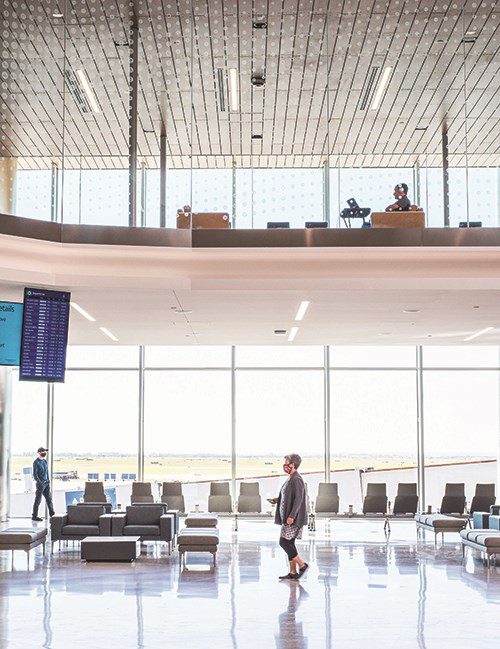With an eye on the present and the future, Will Rogers World Airport (OKC) in Oklahoma City recently added a new East Concourse. Key objectives for the project were twofold: increasing current capacity for passenger screening and planning ahead for more growth in the terminal.
With an eye on the present and the future, Will Rogers World Airport (OKC) in Oklahoma City recently added a new East Concourse. Key objectives for the project were twofold: increasing current capacity for passenger screening and planning ahead for more growth in the terminal.
The 150,000-square-foot expansion includes four new gates, a larger and consolidated passenger screening checkpoint, a public observation mezzanine and space to build a Customs and Immigration area. Select areas of the existing terminal building were also remodeled.
The $89.8 million project was funded with bonds backed by a combination of funding sources including passenger facility charges, local airport funds and FAA Airport Improvement Program entitlement and supplemental grants. (See Facts and Figures box on the right for the specific breakdown.)
|
Project: Terminal Expansion Location: Will Rogers World Airport, Oklahoma City Addition Size: 150,000 sq. ft. Key Components: 4 new gates; consolidated TSA checkpoint; public observation mezzanine; space for future Customs & Immigration area; larger airport administration offices Cost: $89.8 million Funding: Bonds (backed 75% by passenger facility charges, 25% Oklahoma City Airport Trust funds; $10 million FAA Airport Improvement Program grants for terminal apron work (with 90%/10% share); no AIP funds used for terminal itself Construction: March 2019-Nov. 2021 New East Concourse Opened: Sept. 2021 Design Lead: FSB Architects + Engineers, with conceptual design assistance from HOK General Contractor: Timberlake Construction Passenger Data & PFC Support: Jacobsen Daniels Gate Layout: Mott MacDonald Apron Civil Engineering: MacArthur Associated Consultants Seating: Agati; Kusch Checkpoint Queue Aids & Signage: Lavi Industries |
Prior to the recent terminal expansion, OKC experienced congestion in its lobbies and around escalators. Creating a single consolidated checkpoint allowed the airport to repurpose space previously occupied by its two separate checkpoints. New seating areas and other purposeful guest spaces have helped relieve previous congestion in key circulation areas.
Airport Director Jeff Mulder notes that the impact of construction activity was minimal for travelers because the building was expanded on the east end, away from check-in and other main destinations in the still-operating terminal. The addition was built near an existing apron that was completely fenced off, allowing contractors to work exclusively on the non-secure landside, with virtually no impact to the existing terminal.
Oklahoma City–based FSB Architects + Engineers designed the addition, with conceptual design assistance from HOK. Having partnered before on other projects, the two firms began the OKC terminal expansion with a strong working relationship already in place. “The fact that we have fun when we put these projects together comes through,” says HOK Regional Leader of Aviation and Transportation Will Jenkinson. “And it shows in the final product that the addition was developed by a team that really enjoyed what they did together.”
Jacobsen Daniels provided passenger data and other information for space programming purposes and also assisted with the funding eligibility that was based on passenger facility charges. Mott MacDonald planned the layout of the four new gates, and local civil engineering firm MacArthur Associated Consultants assisted with the apron.
New Checkpoint Features
Years of growth in the local population and terminal traffic made expanding the passenger screening area a top priority for OKC officials. “Checkpoint capacity has been a long-term issue here in Oklahoma City,” Mulder relates.
When general contractor Timberlake Construction began work on the terminal expansion in March 2019, the new (and larger) consolidated TSA checkpoint came first and foremost. It opened in mid-September 2021, and crews later remodeled the airport’s two previous checkpoints into meet-and-greet areas.
With COVID top-of-mind during project design, OKC outfitted its new checkpoint with Queue Guard® Germ Shield panels from Lavi Industries. The airport also added magnetic-base stanchions and Swing Gates, also from Lavi. “They reached out to us for help developing a layout for the queuing area that would be both flexible and modular,” explains Perry Kuklin, the company’s marketing director.
 Lavi consequently created a common grid structure throughout the checkpoint space. This allowed OKC to replace lane belts with panels that airport personnel can easily move to shorten or elongate sections of the queue as needed. The clear panels also add physical barriers designed to prevent the spread of COVID and other contagious diseases.
Lavi consequently created a common grid structure throughout the checkpoint space. This allowed OKC to replace lane belts with panels that airport personnel can easily move to shorten or elongate sections of the queue as needed. The clear panels also add physical barriers designed to prevent the spread of COVID and other contagious diseases.
Kuklin notes that OKC can repurpose its Queue Guard panels for marketing or wayfinding signage (if or when a protective barrier is no longer needed) without having to purchase additional pieces. Lavi integrated emergency egress points throughout the queue with Emergency Breakaway Belts. The company also worked with OKC to create branded, color-coded wayfinding signage using its Edge Tower system.
Additional Gates and Amenities
The new expansion could have simply addressed the airport’s two major needs: increased checkpoint capacity and additional gates. However, OKC broadened discussions during the design and planning stages to consider other desirable features. That led to earmarking space for a future Customs and Immigration area and adding a gate specifically to accommodate international flights. Three of the four new gates in the East Concourse are currently leased to Delta Air Lines. The fourth was designed as an airport gate for widebody aircraft, with a separate vestibule for passengers boarding and deplaning from international flights.
Assistant Airport Director Scott Keith explains that OKC receives a lot of diversions, especially from Dallas Fort Worth International Airport, and many are international flights that sometimes need to deplane. “We’ve never had a good spot to do that,” Keith remarks. Until the full Customs and Immigration facility is complete, the airport will take international passengers to a separate holdroom in the lower level of the new concourse.
A special feature added to the non-secure portion of the terminal expansion is an observation mezzanine that allows passengers and the public to watch the airfield traffic. The airport had a similar observation deck years ago, and the project team wanted to bring the popular concept back. “Anybody that’s out on the streets can just walk in and go upstairs and sit and watch planes come in and out of the airport,” says Ryan Manning, senior project manager at Timberlake Construction.
Jenkinson notes that reinventing the observation deck in a post-9/11 environment posed an interesting challenge. “We had a terrific opportunity to invite the public back to airports to get close to aircraft operations and view secure environments, which we solved through design,” he explains. “A graceful and secure observation deck now floats above the town square, giving everyone a chance to experience the joys of flight.”
 Mulder notes that adding the pre-security observation area was a priority of his predecessor, Mark Kranenburg. “That’s a part of this addition that the public can access for a great view of the airfield,” Mulder explains. “It really goes back to what many airports used to have—families and kids and school groups can come out and look at the airfield.”
Mulder notes that adding the pre-security observation area was a priority of his predecessor, Mark Kranenburg. “That’s a part of this addition that the public can access for a great view of the airfield,” Mulder explains. “It really goes back to what many airports used to have—families and kids and school groups can come out and look at the airfield.”
Other terminal upgrades include more spacious restrooms with natural daylight, and new concessions operated by Paradies Lagardère. A Tripadvisor store and three food and beverage options (Vino Volo wine bar/restaurant, Freddy’s Frozen Custard and Steakburgers and Starbucks) opened last fall. Tropical Smoothie was added this March, and more new concessions are scheduled to come online this year, including Tin Lizzi’s, Osteria, Plenty Mercantile, Hatch Early Morning Food and others.
The design team specified a variety of seating options and tables with built-in power to make it easy for guests to charge their portable electronics. Products supplied by Agati and Kusch include swiveling chairs with high backrests, beam seating for holdrooms, and loungers positioned in front of windows to encourage relaxation.
As attractive as the seating and other new interior elements are, the aesthetic star of the terminal expansion is a terrazzo floor mosaic. Personnel from FSB Architects + Engineers, HOK and the airport worked with artist Matt Goad, who created OKConnected to showcase the local and state culture. Goad’s striking artwork includes images of airport namesake Will Rogers, the 1996 bombing of the Oklahoma City Federal Building, Civilized Tribes of Oklahoma and regional industry and agriculture. “You’ll see something new every time you come through because the mosaic is so vast,” Keith comments. “It is truly something unique.”
Airport officials instructed Lavi Industries to maintain the integrity and visibility of the artwork integrated into the terrazzo flooring when outfitting the new checkpoint with queue panels and other accessories. “The mosaic was a very important aspect of the terminal remodel,” notes Kuklin.

Layout and Design
When the airport’s last master plan was created in the early 2000s, it included provisions to add a new concourse on the east side of the terminal by essentially duplicating the existing concourse on the west. But after reviewing the plan, architects determined it would be better to make the new concourse wider. “We didn’t mirror the west concourse,” says Keith. “Instead, we hung a concourse on the east that’s a little different shape.”
 The new shape, he explains, allowed the airport to add more features, including the observation gallery and space for an international holdroom in the future. “All of those things kind of fell out of doing a lot of planning work upfront to create the right shape that integrates well on our east side,” Keith reflects.
The new shape, he explains, allowed the airport to add more features, including the observation gallery and space for an international holdroom in the future. “All of those things kind of fell out of doing a lot of planning work upfront to create the right shape that integrates well on our east side,” Keith reflects.
The airport considered adding the new consolidated checkpoint to the existing West Concourse, but options there were impractical, expensive and would infringe on ticket counters or other needed spaces. “It became more and more apparent that we just needed to stick this on the other end of the building and make it the center focus, because the next expansion as we move into the future, whenever that comes, is going to have to go to the east,” Keith explains.
When airport officials met with the design team at beginning of the project, they made it clear they wanted to transform OKC from a good regional airport into a standout facility for business and leisure travelers alike. “We tried to take that approach and develop a really world-class experience in the new wing…and make the space feel like it really belongs to the community,” says HOK’s Jenkinson.
Designers wanted the expansion to feel like it was very much a part of the existing terminal without being a direct copy, so they took cues for materials and use of daylight from the existing building. They specified local stone throughout the new addition and updated the flooring from tile to terrazzo to establish the East Concourse as the modern wing of the airport. “It is appropriately contemporary to react to the industry of today and the needs of the airport,” Jenkinson says.
The design team also took energy efficiency into consideration. “We did a lot of energy modeling to make sure that we were right-sizing the equipment for efficiency,” says Mark Timbrook, FSB Architects + Engineers aviation project principal.
 Designers studied the sun’s orientation to help determine where to use glazing and leverage the natural daylight versus where to specify solid materials. “We positioned what we call an oculus, or a lightwell, above the town square to harvest natural daylight,” Jenkinson notes.
Designers studied the sun’s orientation to help determine where to use glazing and leverage the natural daylight versus where to specify solid materials. “We positioned what we call an oculus, or a lightwell, above the town square to harvest natural daylight,” Jenkinson notes.
To “future-proof” the new concourse, architects made the facility easy to expand, without the need to decommission or demolish significant parts of the existing building. “It’s a sustainable approach to long-term development through planning,” Jenkinson remarks.
In addition to building a new concourse, OKC remodeled approximately 21,000 square feet of its existing space to relocate an elevator in the ticketing lobby that had been considered an obstruction for years.
Insight and Advice
The project team encountered some surprises regarding the logistics of attaching a new concourse to OKC’s existing terminal structure—for instance, the floor elevations of the existing terminal did not match the construction plans that were developed from as-built drawings. Foundations were started and drilled piers were going in when the discrepancy was discovered, says OKC Manager of Planning and Development John Storms.
“Do in-depth investigation on the building you’re going to hook onto before you start,” Keith advises. “That cost us some dollars and some time.”
“Project challenges do arise, but we work closely and proactively with our project partners and client to find solutions that fit within the budget and timeline,” Jenkinson adds.
Working with a third-party owner representative or program manager was a big plus, notes Storms. “They can take up some of your issues and try to work them out and come back to you with solutions,” he says.
 Manning emphasizes the role of effective phasing and construction scheduling, especially when areas need to be shut down for demolition and remodeling. “Upfront, come up with a really good plan and make sure you work that plan,” he suggests.
Manning emphasizes the role of effective phasing and construction scheduling, especially when areas need to be shut down for demolition and remodeling. “Upfront, come up with a really good plan and make sure you work that plan,” he suggests.
Mulder notes the importance of preparing customers for changes in traffic flow and directing them to and through new facilities. “People have been used to going to the same checkpoints for years, and they still show up at the same location,” he explains. “You have to be ready to tweak the signage once the space opens because you just can’t anticipate it all.”
After opening the new East Concourse in September 2021, Mulder says there’s nothing like being out in the facility to watch where bottlenecks occur and learn where people are getting lost.
 Looking ahead, Timbrook says that it’s vital to safeguard future operations because technology changes very quickly. “Don’t rush the planning and programming process,” he remarks. “It really is important to take your time making sure that you understand everything.”
Looking ahead, Timbrook says that it’s vital to safeguard future operations because technology changes very quickly. “Don’t rush the planning and programming process,” he remarks. “It really is important to take your time making sure that you understand everything.”
“The rest of this stuff is easy to solve,” Timbrook adds. “But if you don’t know where you’re going, it’s so hard to get there.”
Timbrook also believes it’s important to incorporate local components, especially in small or regional airports. At OKC, local stone and the terrazzo mosaic both make it clear to visitors that they’re in Oklahoma City.


 facts&figures
facts&figures

